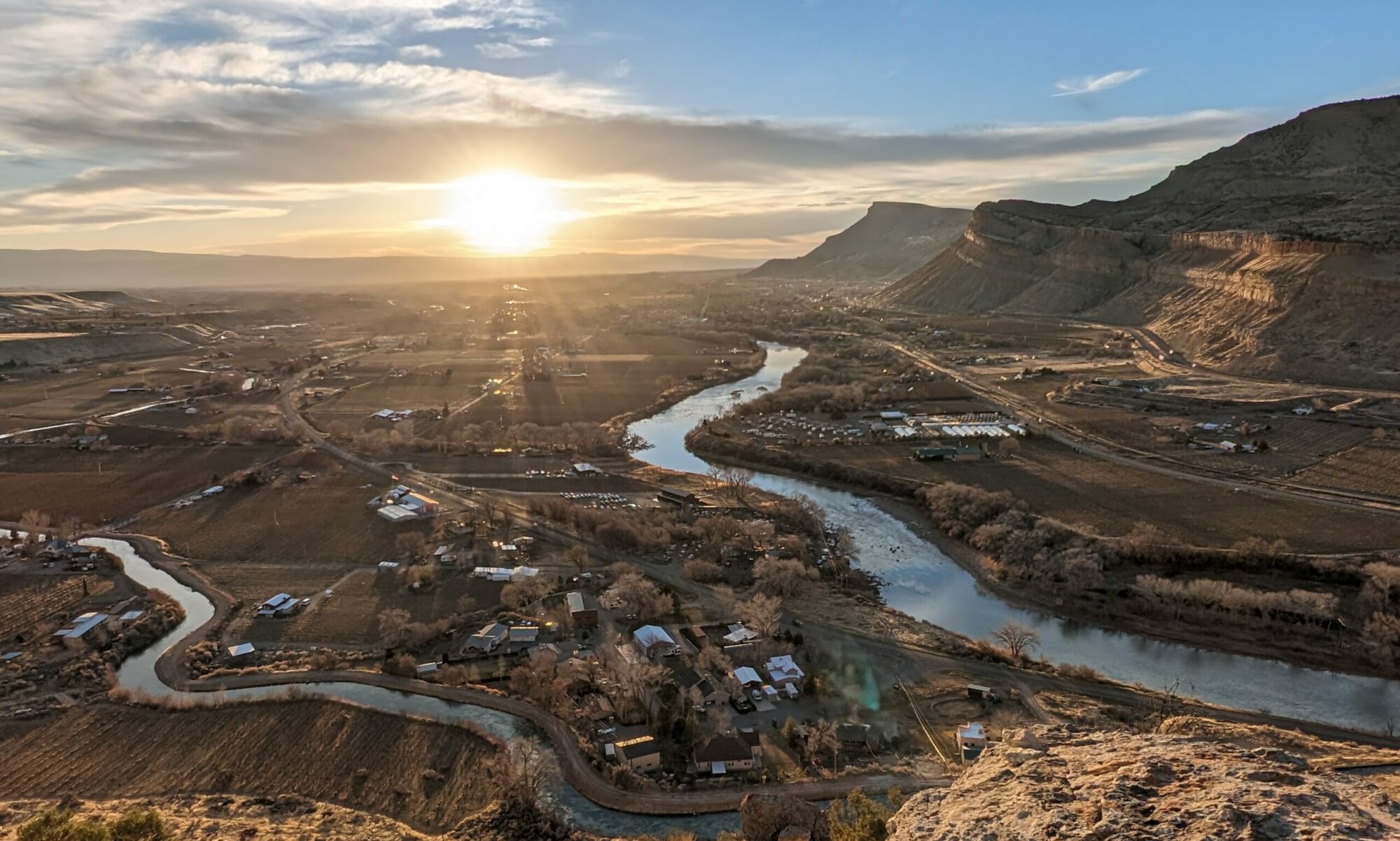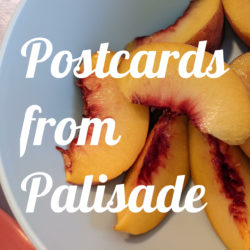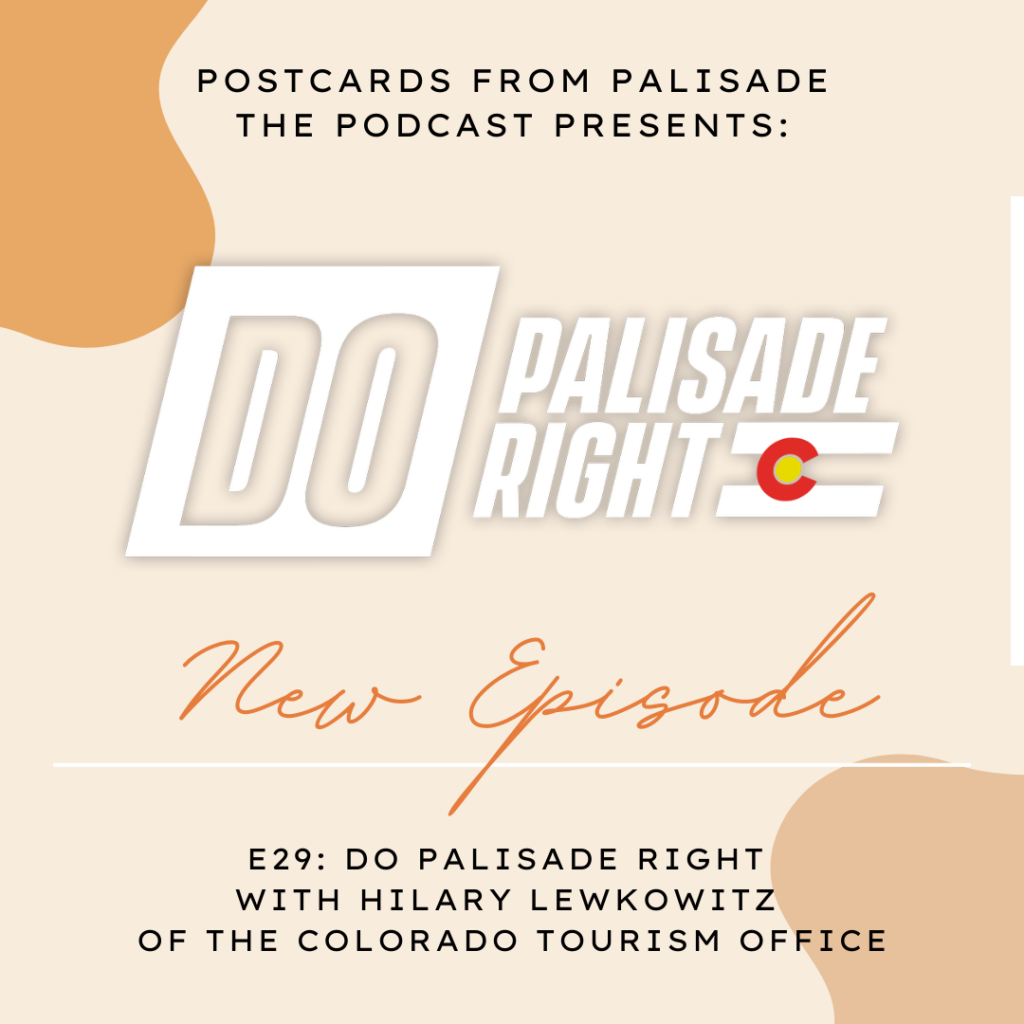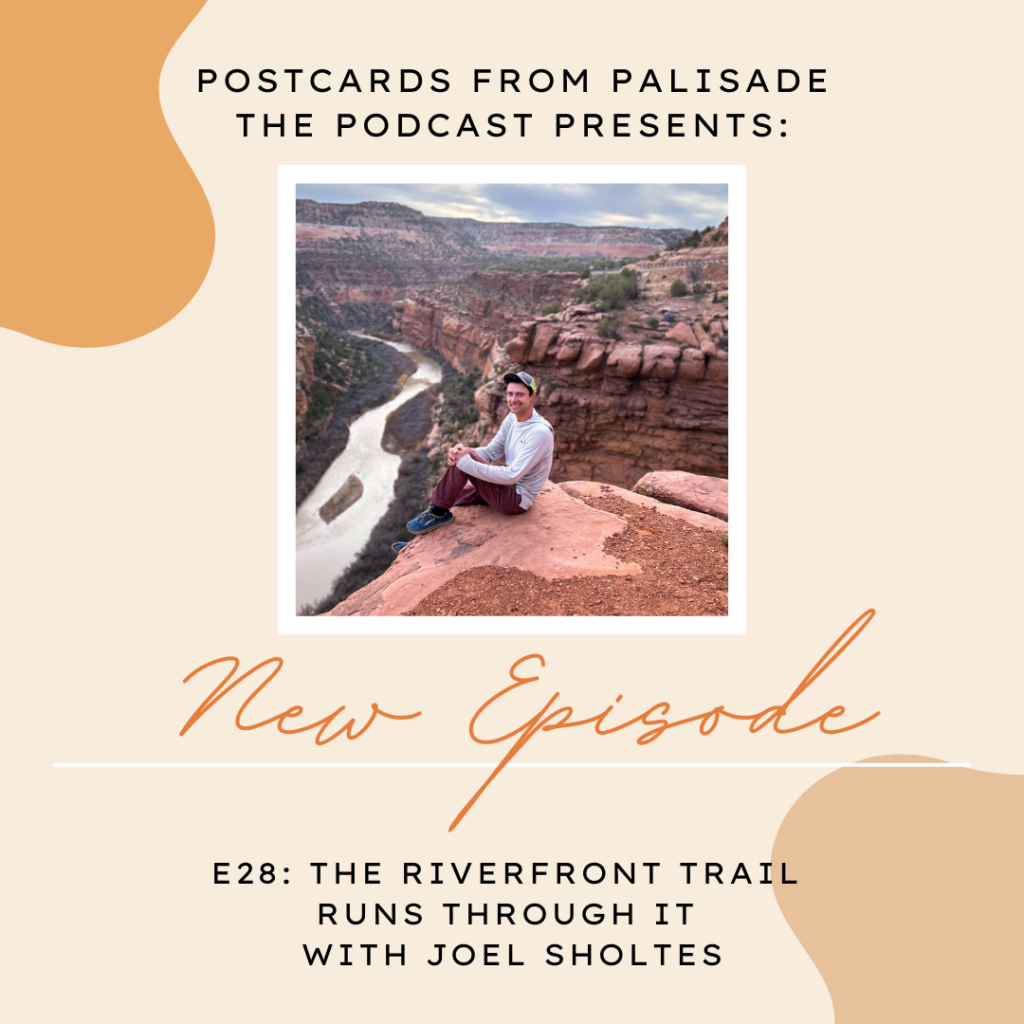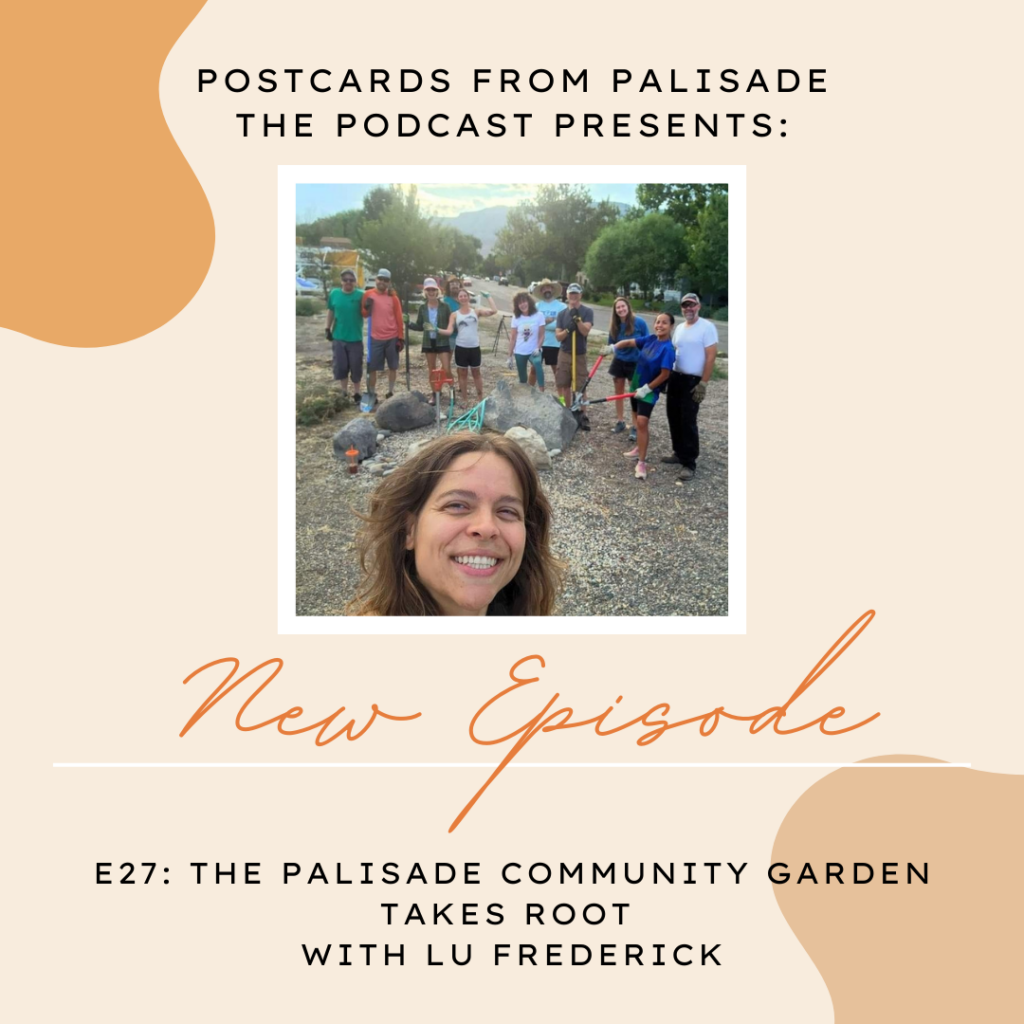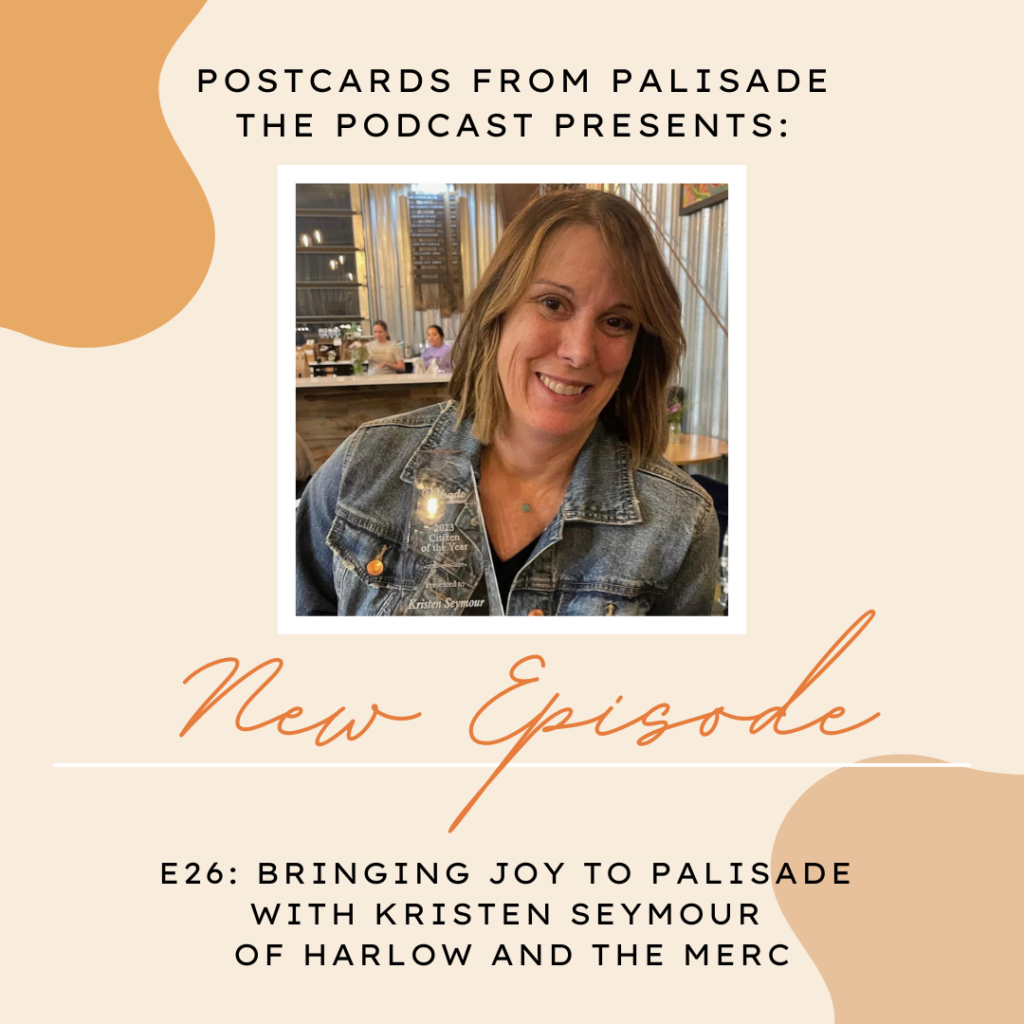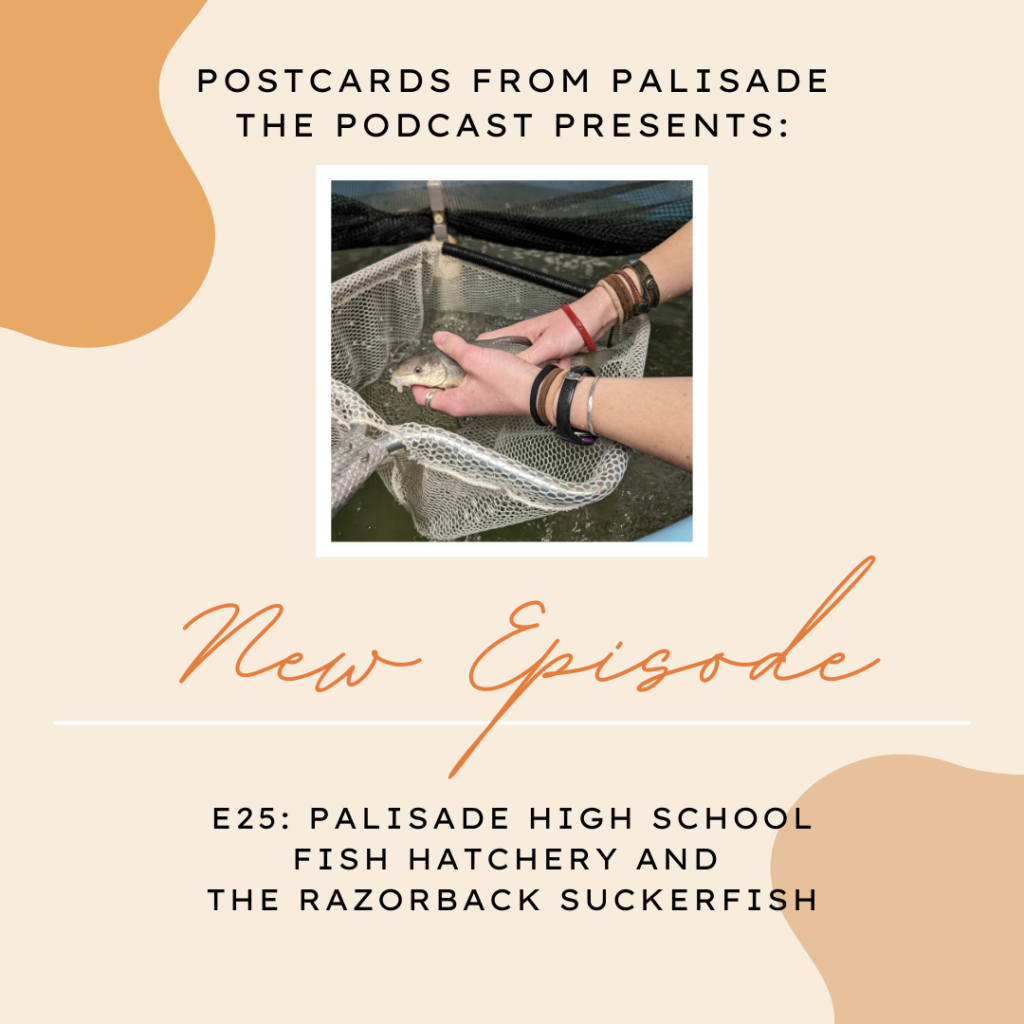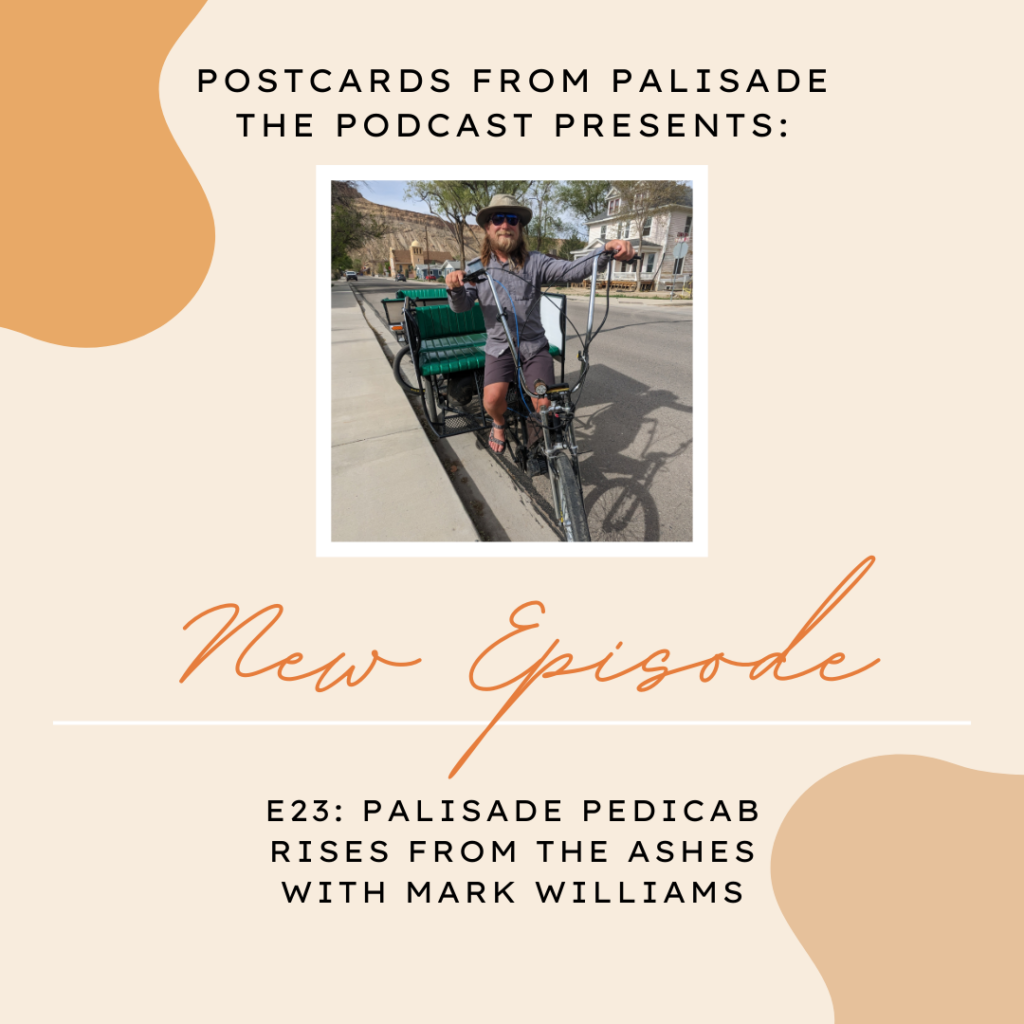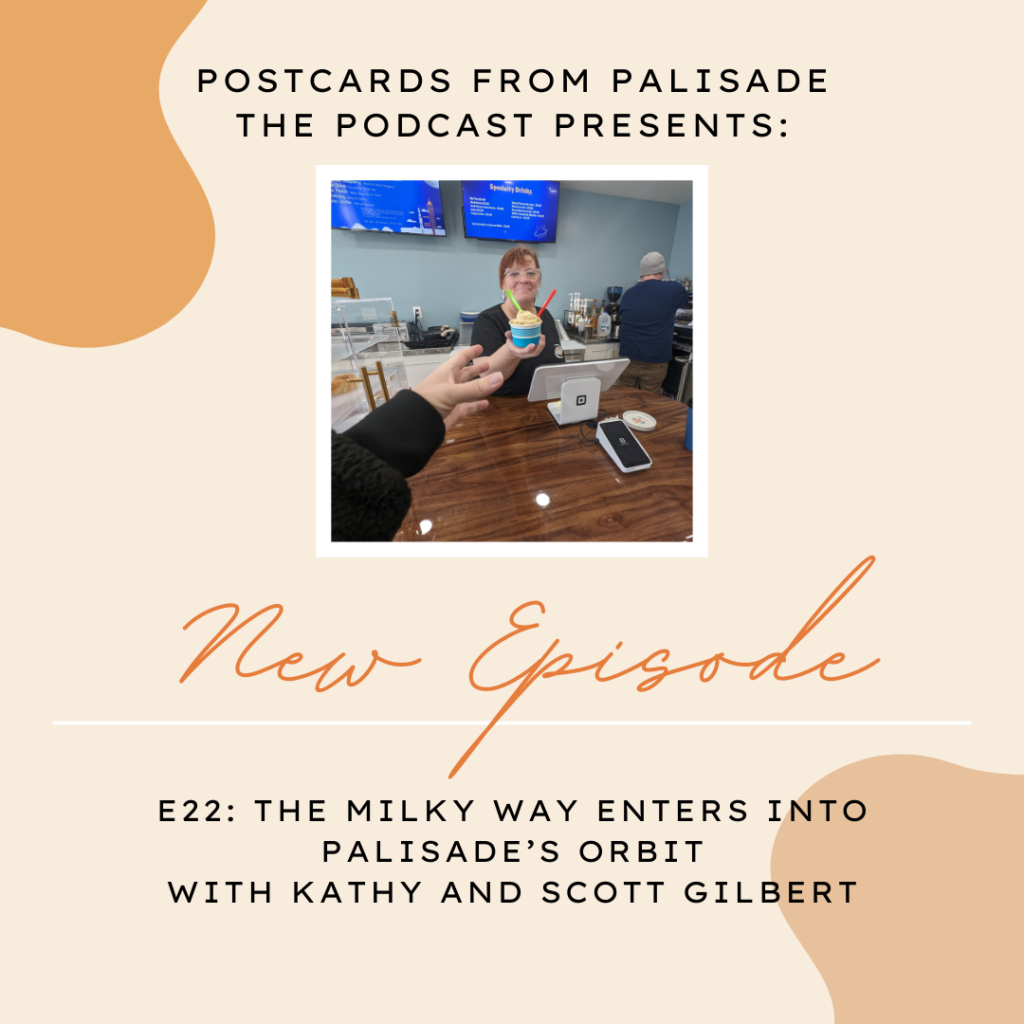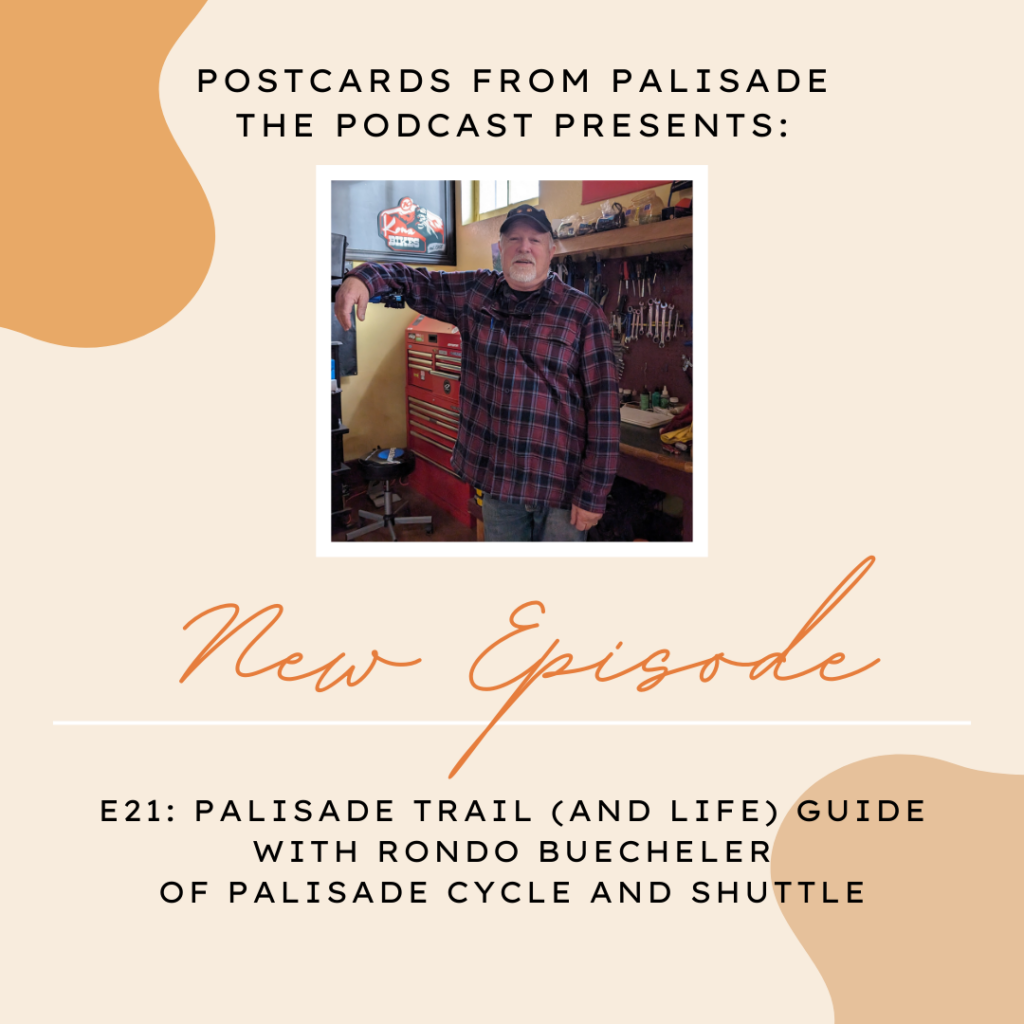Join JoAnn Rasmussen, Chair of the Palisade Historical Society, and me on a fun journey through Palisade’s past, present, and future and catch her contagious love of history in general and Palisade history in particular.
We chat about the Palisade Historical Society’s project to digitize the entire archive of the Palisade Tribune and what you can learn from old newspapers, the historic houses of Palisade, and what the town of Palisade did before it had an ambulance.
Learn all about who put the flagpole on the cliffs above Palisade and who changes the flag now, the first pickleball court in Mesa County, the best obituary in the Palisade Tribune, whether we believe in ghosts, and what people are going to be talking about in Palisade 100 years from today.
More about the Palisade Historical Society: LINK
More about the historic issues of the Palisade Tribune: LINK
More about the Palisade History Museum: LINK
Theme Music: Riverbend by Geoff Roper.
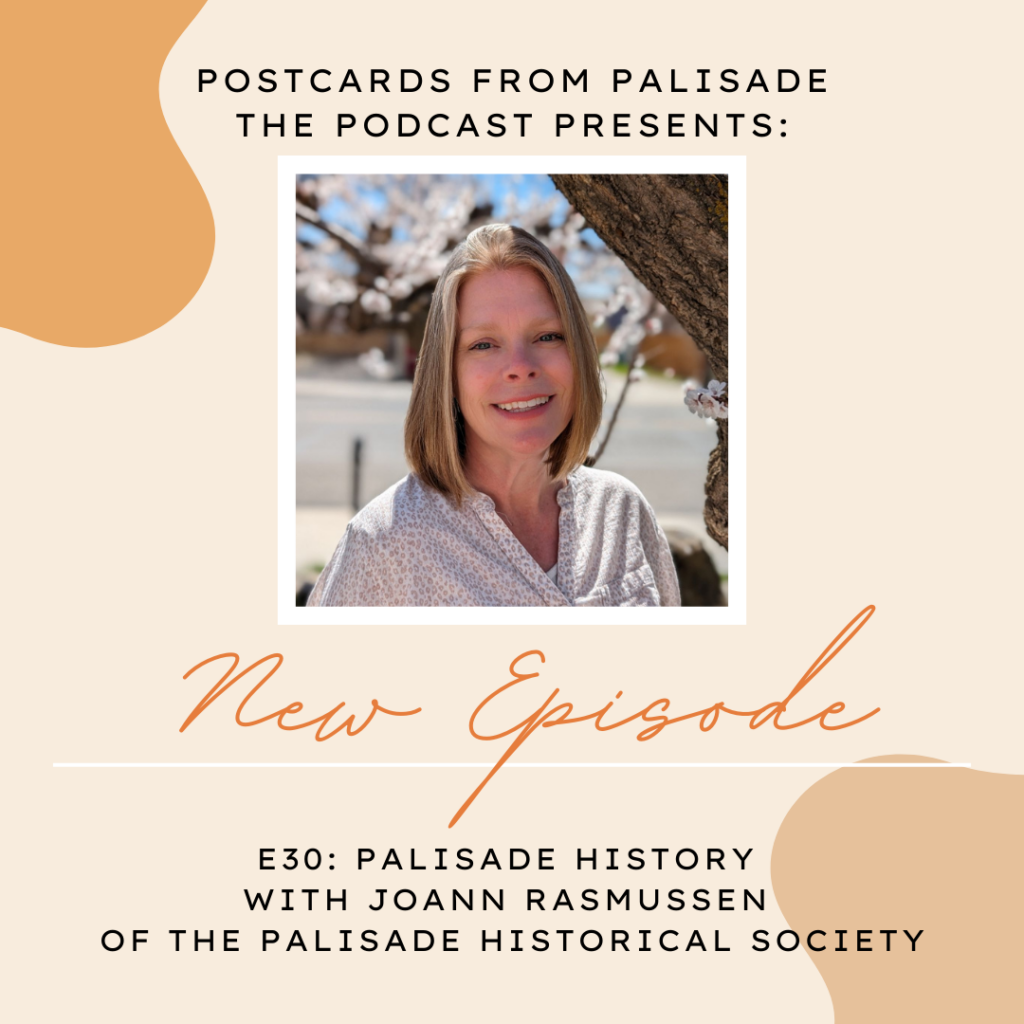
Subscribe:
Transcript:
Welcome to Postcards From Palisade, where we hear from the people who are shaping our slice of western Colorado. I’m Lisa McNamara.
Today I’m joined by JoAnn Rasmussen.
JoAnn Rasmussen: All right. I’m JoAnn Rasmussen. I’m chair of the Palisade Historical Society.
LM: And.
JR: I never know how much of an introduction you want or how long this is going to be. So how much time do you have?
LM: There’s no time limit. I mean, it’s basically like, well, I like to keep it under an hour so that I don’t have to spend too much time editing things. But that’s really. That’s just a rough guideline.
JR: I mean, can we just start over, or do you want me to.
LM: No. Yeah. Well, sure.
JR: Okay. I’m JoAnn Rasmussen, chair of the Palisade Historical Society, and I’m one of the co-owners of the historic Crissey house, which is the only residence in Palisade on the National Register of Historic Places.
LM: Awesome. and.
JR: And I was recently appointed to TAB, which is the tourism advisory board here for the town of Palisade.
JoAnn shares her contagious love of history in general and Palisade history in particular as we dive into Palisade’s past, present, and future. Hear about the Palisade Historical Society’s project to digitize the entire archive of the Palisade Tribune, what you can learn from old newspapers, the historic houses of Palisade, what the town of Palisade did before it had an ambulance, who put the flagpole on the cliffs above Palisade and who changes the flag now, the first pickleball court in Mesa County, the best obituary in the Palisade Tribune, whether we believe in ghosts, and what people are going to be talking about in Palisade 100 years from today.
All that and more, on today’s Postcard from Palisade.
LM: so what made you interested in getting involved with a historical society?
JR: So, I’ve always been interested in history. In fact, when I graduated from high school, one of the gifts that my parents gave me was a lifetime membership to our little, tiny local historical society, which is really pretty cool. and I had volunteered, back in the late 19 hundreds doing some stuff for them.
LM: Oh it sounds really bad when you say it that way.
JR: Right. But it’s true. but honestly, it wasn’t even on our radar at all until this property popped up. And to give you a little bit of background on that, we were living in the Denver metro, and we’d been there for over 20 years in the particular house we were in. And we’d always done all of the remodeling work and all of that on our own house. And that was built in 1977, which we thought at the time was an older home.
LM: historic.
JR: An older home. Right. And the original plan was we were going to move somewhere slower paced when our daughter graduated from high school. And at that point, we had a few years before that was even going to happen. So in 2019, we came out to the western slope to check it out. Despite living in Colorado for almost 25 years, we’d never been on this side of the mountains, truly. And we fell in love with it. And we ended up doing a little day trip, a little jaunt on the way back through Palisade, and we absolutely loved it. And so one of the things that I do, one of my hobbies, if you will, is on zillow. I will put in little towns that, we love, and eventually, someday, maybe we could retire there or something like that. So I put this into Zillow. I put Palisade into zillow, never thinking about it again, really. And fast forward, the pandemic happens. We are 100% remote in our. In our daily lives. Our daughter is 100% remote for the last half of her 8th grade year, her entire freshman year was also 100% remote. And that. Let’s see, late spring, early summer of 21, zillow alerts me.
LM: It was like, hey, JoAnn.
JR: Hey. By the way, there’s a house that doesn’t meet your criteria at all, because it’s not a single level ranch that doesn’t need any work. It is a two story historic property. But it’s in Palisade. And you liked Palisade. And so I open it up and I look at it, and my husband sees the carriage house, the picture of the carriage house in the back, and he was like, oh, maybe. Maybe we should look at that. And I’m like, what? Why? Really? Because we’ve been jokingly telling everyone that we’re going to be moving for the last 20 years, and we just. We never have. That’s not even on our. That’s not even on our radar. What are you talking about?
But, along with the entire world, our priorities had shifted. And we sat down and were like, why were we waiting? What was the reason? And those reasons had changed. And so we thought, well, we’ll look at it. We can go and look at the house. We can’t get out there until the end of July. And at that point in real estate history, especially in the Denver metro, houses were flying off the shelf. They were going within 24 hours. Well over asking, it was just crazy. And so we could not get out until the end of July. And so we thought, well, if the house isn’t available, then it wasn’t supposed to be our house. But it doesn’t hurt to at least put in a little plan to. To go check it out.
So we did. And we were able, as luck would have it, we were able to hook up with a tour at the high school, local tour. The principal gave us a tour, fell in love with the high school, fell in love with the town. We rented a little Vrbo in town so we could actually say we’d stay, stayed overnight in Palisade for at least a couple days to see what it’s like. And we loved it. You can see the stars at night. You can see the Milky Way. You can walk around and not have to worry about the things that we had been worrying about in the Denver metro. It was just absolutely amazing. So we fell in love with this house, and we noticed that it had a sign in the window that said, number ten, Palisade historic walking tour. I’m like, oh, what’s that? Come to find out that we are on the walking tour and that Palisade has a historical society. And so that’s kind of how we got involved with that.
we knew it was on the national register. It was on the register of historic places, and we knew it needed some work, but we didn’t know quite how much work it needed, and we didn’t really know what that entailed, being on the register. And now I know. Now I know all of that, and we would do it again in a heartbeat, which means there probably is something wrong with us. But. So I met, Priscilla Walker. She is the founding chair of the Palisade Historical Society right after we moved in. And she was very. She was very engaging and very nice and also very careful not to push us into being involved right away because we were up to our eyeballs in contractors and projects and just trying to get moved in and trying to get everything, at least livable.
LM: livable right?
JR: well. And it was livable. It was livable. your standards are a little different, you know, with a sewer line that’s actively leaking. But it was livable. and about a year and a half, my main job. So around that time is when we met, Priscilla Walker, founding chair of the Palisade Historical Society. And we were in the midst of all of these other projects, just trying to get our head above water. like I said, we were up to our eyeballs in these projects. And as many metaphors as I can mix, I will.
so my job for the first year and a half was managing all of the contractors at the house. So when we did all of the work on our previous house in Arvada, we did all the work. I can count on half of one hand the number of contractors that we hired out. that was 20 years ago. We’re different people now. And now we’ve decided to stimulate the local economy by hiring experts to do these things. Plus, we had things that were just above our ability and things we didn’t want to do but needed to be done.
And so after about a year and a half, Priscilla and I were talking and she mentioned that there was an opening on their board, their board of directors. And I have a lot of board experience, executive board experience. I was on a school board, on the front range for six years. I’ve been on various boards of differing organizations. Casual and not so casual. And so I said, sure, I’d love to. And so I came on the board as vice chair. And Priscilla and I make a great team, if I can say that myself. We do. We make a great team. She is a fantastic, phenomenal person. And she’s been doing so much herself with help of a team. And she’s humble and she will say that it’s not her and that it’s the team, but it really is her. And she does have help. But she had been taking on so much, and so I was able to take some things off of her plate. And then after doing that for a year, they elected me as chair. So we swapped roles. She jokes that she’s been demoted, which is not true. And I joke that my salary has doubled, which is actually true. Zero times zero is still zero. and it has been so much fun. And the thing, I think the original question was, how did I get involved with the history of this or the historical society?
LM: Or yeah, why were you interested in getting involved?
JR: Right. History, to me, is so incredibly important. If we can’t understand where we came from, we don’t understand at all where we’re going to be. And the thing about history is people think that it is static or it’s a stationary thing, and that’s true. But our understanding of it can grow and change over time,
LM: absolutely.
JR: especially with, the historical society has been, digitizing the Palisade Tribunes. So the Palisade Tribune was our newspaper of record from 1903 until they closed in March of 2014. And the Palisade historical society was able to negotiate with the attorneys, the preservation of those papers. So we have those papers, and then we’ve been working with the Colorado historic newspaper collection to get those digitized. And it’s a free database. you can log in, you can search for all kinds of things. And because we have access to all of that now, I think we have them up to, like, 1978, I think, is how far we are. Now. We have another batch that we just sent over.
And donations to the Palisade Historical society help us fund that because we’re a 501c3. All of our staff at the museum, we’re all volunteer. We all volunteer our time. So donations is really how we exist and how we can do this. But because we have access to that now, we can verify some of those things from the past that either, yes, they really did happen on that day. Now, there’s mistakes. There’s always mistakes. I mean, if you read the paper today, there’s probably a mistake here or there. but what it helps you do is it helps you pinpoint a specific moment in time when something like that happened. Like, if they’re reporting on November 15, 1915, that this building burned down, then you know that it burned down at that time, that type of thing.
LM: Sure. Yeah. And the cool thing about it, too, that the database of the newspapers is it’s searchable. it’s not just digitized, like, as an image, but the text is searchable, which is really cool. So if you want to know about a specific event or property or anything like that, you can search the database. So I’ll put a link to that in the, episode notes. But it’s a really cool thing. And just to think that, I mean, your goal is to get all the episodes or all of the editions up until 2014 digitized. Right?
JR: Yes.
LM: So eventually it’ll all be out there.
JR: Eventually it will be. And it’s really neat. So they use, I think it’s called OCR, which is basically our robot overlords have gone in. So it looks at it, it scans it, and it puts in what it thinks, what it thinks they are. it’s tricky because things can be spelled wrong, and the font that they’ve used can be tricky to see for that scan, to actually put down the correct letters. And then also, when you’re working with newsprint, if you hold newsprint up to the light, you can see an image through from the other side. And so that can kind of mess with it. Mess with it, too. So one of the tips and tricks that we give people is to search for things that are misspelled. Search for things that, for example, Fruita. Sometimes the f would look like a p. So it’s going to be recorded as Pruita in that part.
LM: So think about how you can outsmart the machine. Basically.
JR: Outsmart the machine. There is. There is a way to go in and make edits to that. I think Priscilla does that quite a bit. I am afraid to start that because as soon as I do, hours will have gone by.
LM: Oh, yeah.
JR: Then I’m down another rabbit hole.
LM: Tell me about it. That’s like when I, before I got this job, I found this, transcription site through the Smithsonian where you can do volunteer transcription on, like, archives and old letters, like, correspondence between, gallery owners and artists. And, man, did I get. I had to, like, force myself to stop working on that. It was very fun.
JR: Right, right. I know. Just hours just vanished.
LM: Yeah. I’d be like, Paul, one more letter. One more letter, and then I’ll stop. And then I’d be like, two more. And, like, I’ll stop soon.
JR: Well, and that’s how it is when I’m researching these things. I’ll start researching one thing and then end up in a completely different place, but in such a magical moment. one of the things I was trying to do was figure out when our house was actually built. And you would think of all of the properties we would know because it’s on the national register. But, it was put on the register with kind of a nebulous time frame, like, they thought it was built between 1905 and 1907. And we knew the family moved in in 1909 because I found a Palisade tribune article from when they did. And in theory, that house could have been built in four years. That’s. That’s absolutely plausible. But I really wanted to know, like, I really, really wanted to know when was it built?
And when you contact Mesa county and look at all the Mesa county records, a lot of times it’ll say 1908, but that’s because that’s when it was put on the tax register. That’s not necessarily when it was built. as it turns out, it really was 1908, and I found that in the Palisade tribute. But in doing that, I found, information about another property in town that was absolutely fascinating. and especially maybe only because I’m part of the historical society and we do the walking tour brochures and talking about how history is what it is or was, but then how. How we understand it can change. We are constantly updating information in the historic walking tour brochures. if you want, I can go into. I can go into what I found about that house, the other house.
LM: sure!
JR: So, I don’t know if you’re familiar with the big yellow mansion at the end of Main street, right by highway six. So if you’re standing on Main street and you look all the way down, it’s right across from the T intersection.
LM: Is it the one that’s for sale right now?
JR: It is for sale right now.
LM: Oh, yeah.
JR: Zillow let me know that this one was for sale, too.
LM: Yes, I am familiar with it. It’s really not because I looked at all the pictures.
JR: It is. It is. So, originally, and a lot of times people in town will call that the old Whistler house or the old swisher house. And originally we thought, it was called the Whistler or Swisher House both. It was kind of interchangeable. And the rumor was that there had been a swimming pool that was built on that property. And with all the stories and research that I’ve done, everything is intertwined. So someone had said that there had been a swimming pool on the property and that they knew who the new owners were. And eventually we could connect and, you know, figure out this information for the historical society.
But when I was researching for when my house was built or the Crissey house was built, I discovered that they’re intertwined, and here’s why. So, in 1903, Charles Whistler made the river cliff bathhouse on that property. He created this river cliff bathhouse, and it was basically a community swimming pool that had different hours on various days for men or women to go you couldn’t go together. And swimsuits, were provided.
LM: ew!
JR: and I’m like, this is crazy. So that’s really interesting. And I found all of these ads for the river cliff bathhouse in the Palisade Tribune.
LM: Cool. Very cool.
JR: With little poems. And, I mean, it was, it was amazing. Then he sold that land to, Mr. Crissey, which is how it popped up on my radar. And so in 1906, Mr. Crissey built the original house that was there. And we think he used the bathhouse as the basement, or it was closer to the river. But either way, the people who currently own it now never found any remnants of a swimming pool when they were remodeling. So Mr. Crissey is the one who built the house. Not swisher, not whistler.
LM: Okay.
JR: so we’re like, well, how did, how did swisher come into play? So, in 1908, a man by the name of Frank swisher came from Kansas and saw this peach ranch orchard. And side note, I think it’s so funny when people call them peach ranches, because I picture little peaches, like, with legs.
LM: with legs! Totally! That’s exactly what popped into my head.
JR: I’m from Iowa, where we have farms. I’m using air quotes right now, right? Not ranches. And so whenever anybody says peach ranch, I picture him, like, wrangling up little. Okay. Sorry.
LM: no, that’s exactly where my mind went. I was like a peach on legs, mooing.
JR: Exactly, they’re moving around, and they’re docile little critters. But anyway, funny side note, anyway, this man is interested in this land. And so Crissey’s like, sure, I’ll sell it to you for, $4,000 an acre, which at the time, in 1908, was a ridiculous amount of money. And he said, okay, here you go. So he sold his six acres of peaches and his house for $24,000. And this was an infamous land deal. It hit the Daily Sentinel paper, Palisade Tribune is covering this. And I can only imagine the conversation that Mr. Crissey, that Grant had with May when he went, you know, over supper that night of, oh, by the way, we need to pack again, because this beautiful house that I have built you is now someone else’s.
LM: But we’re rich, so.
JR: But we’re rich. And he was already rich. I mean, to be fair, he was already doing well because he was in irrigation and banking. And, later he became, part of the United Fruit Growers association. So he was, yeah, he was very, very prosperous. But what’s interesting about that is knowing that our house was started. They started building it in December of 1908. And then they moved in in May of 1909. It was basically six months.
LM: Wow. That’s fast for back in the day.
JR: to construct this house. In the meantime, I was able to connect with the current owner of the house, and she gave me a tour, and they did. They remodeled this house, and the craftsmanship is absolutely phenomenal.
LM: You’re talking the swisher house.
JR: The swisher house, yeah. So they, found contractors and woodworkers that could make everything look like it really was from 1908. And so when you’re in the house, you can’t really tell where the original house ends and the current house begins. But what was absolutely fascinating to me is when we got into. Because I came in the back, and, you know, we’re looking at all this beautiful, beautiful work, and then we go to the front room, and the columns in my house are the exact same as the ones in her house. The wood fretwork above the doorway is very, very similar to the. The fretwork we have. And you can tell that H. G. Crissey had a hand in this. And unless you’ve been in both houses, you wouldn’t. You wouldn’t really find that connection. And we were able to verify that connection and discover it through the Palisade tribunes, which is really pretty cool.
LM: Very cool.
JR: I think.
LM: So, wait. Sorry. I don’t want to. I don’t want to stop. If you’re not done with that story yet.
JR: Oh, I could go on and on forever. I think we’ve come to a natural pause in my story.
LM: All right, well, one of the things I asked you to think about was what your favorite stories about Palisade are, and I know that is. That would definitely be one of them, right?
JR: Yes.
LM: The houses and the cool. The relationship with, like, we have these really awesome Historic houses that were preserved in great condition. And, But what are the other things that you think, like, as you started learning about the town and the history. Like, what are a couple other things that you just thought were like, wow, that’s really cool, or it’s so cool that happened here.
JR: one in particular is just. It’s comical to me. I mean, it could have. It could have ended in tragedy, and it didn’t, and then it just kind of takes a comical turn. so there’s a man that used to live in Palisade. He was well known here. his name was Jack Webb, and we have his oral history on the Palisade Historical Society’s website. So historicpalisade.org. We’ve been doing some revamping there. We, have, a whole page of the oral histories, and so you can go through and read the transcripts of those. And he has some items that are in the Palisade history museum.
And so to give you some background on him, in 1942, he wanted to enlist in the marines, but he was 16, and they said, well, we’re not taking 16 year olds this month, so I’ll just put down that you’re 17. So. So he enlisted in the marines, and he had a. He had a long, varied history of things, but he ended up being a coal miner. And Palisade, if you’re not familiar, had 14, or we had more than a dozen active coal mines in the book cliffs around us in the Palisades. That’s how Palisade gets its name, here north of town.
And in the early fifties or late forties, he was working in a mine, up at Cameo, and there was a cave in, and he was rescued because he happened to be near what’s called bug dust, which is when you’re drilling, it’s this fine powder that. That comes out of the hole, from my understanding, and creates this softer. This softer thing. So there was a cave in, and they were able to get to him, and he was alive. He was unconscious. They get him out of the mine, and they get him on a stretcher. He has to go down the railroad to town. They have to take him to St. Mary’s. And the only way to go to St. Mary’s they didn’t have an ambulance at the time. The only way to transport someone was in a hearse, because he’s on a stretcher, right?
LM: Right.
JR: So the only way to transport him is in a hearse. He wakes up on the way to the hospital in the hearse.
LM: Oh, my God.
JR: And thinks he’s died because he’s woken up in a hearse. And that’s really the only explanation. Right?
LM: Yeah.
JR: we have. So there was a piece of coal that he found in his pocket after that cave in that he then kept as his good luck charm. So we’ve got that at the museum. We’ve got his. His lunch pail and, other, other things from the mine. But to me that it’s just a funny story. I mean, it could. It was tragic. Cave ins are tragic. But to think that you’ve died because you woke up in the back of a hearse when the reality is Palisade didn’t have an ambulance at that time.
LM: Oh, that’s crazy. That’s cool though that you have the piece of coal. That’s very cool. I want to come check that out. I have to admit, I haven’t been to the historical society yet. Museum. The history museum.
JR: You should come. You should come. So it, Let’s see. We opened that. I say we. This happened before we got here. they opened in August of 2021.
LM: Okay.
JR: I think it was August of 2021. Priscilla will have my head if I’m not right. 2021 for sure. No, it was, it was. It was August of 2021. And, we’ve already had over 1700 visitors in almost three years that we’ve been open. it’s a lot bigger on the inside than it looks on the outside. It’s a little log cabin down at the corner of Elberta and the frontage road for highway six. And it was built in 1939. It was the Bunte. So the Buntes are the family that owned it. And it was kind of like a service station for, trucks and orchard trucks and that type of thing.
LM: interesting . And does it have a regular schedule of when it’s open?
JR: We do, yeah. So Tuesday, Thursday, Friday and Saturday from ten to two. And if those hours don’t work for you, then we, can do by appointment also. So the number to call to schedule that would be, 970-812-3064 and all of that information is also at historicpalisade.org and we would be happy to give a private tour if we’re available. or if you have family in town, and those hours don’t work for you. but it’s. It’s really pretty neat because it talks about the coal mining. It talks about how important irrigation is. It talks about peaches, of course, and everything that goes into that. and it is. It’s a lot bigger on the inside than it appears on the outside.
LM: Yeah. And you can get things like the historic walking tour brochures and things like that there. Right. Are there other places around town you can pick those up?
JR: So there’s a map on the back of food town, and we have a display there, too. So there’s free, brochures there. I think you can get them at the chamber. we have, various places around town you can get the free walking tour brochure.
LM: Yeah. So that’s a cool thing when people are like, I want to do something, and I’m tired of drinking wine, you know, it’s like, there are a lot of other things you can do. are there any other stories or things that you want to highlight that you feel like are really cool parts of our history?
JR: Oh, there’s so. I mean, there are so many. There are so many different things. One thing that people might not realize, and I think we’re gonna do a history talk on this, too, is the flag above Palisade. Did you know about the flag above.
LM: The one on Garfield or the one that’s on stagecoach?
JR: the one that’s on stagecoach. So it’s on Mount Lincoln. It’s, right there by Mount Lincoln, technically. So there is one on Mount Garfield, and most of the time, people think that’s the one that we’re referring to. But there is a flag directly above Palisade, up off of stagecoach trail. And, my husband and I were able to go up there. We’ve gone up there a couple times. There’s a gentleman here in town that changes the flag every few months. And, my husband and I tried to get to the flag on our own and ended up doing, what, 6.6 miles of the 5.2 miles hike.
LM: You went straight, you didn’t turn left? Right.
JR: Maybe we should have taken the left turn at Albuquerque and did not.
LM: No, the first time we went up there, we definitely walked about 6 miles and finally to figure out where it was.
JR: Yeah. So you have been up to the flag, too.
LM: Yeah, I really like that hike, because, well, we’re not gonna tell people where it is.
JR: No
LM: not many people know about it
JR: it’s a secret
LM: And, yeah, you’re kind of guaranteed to just have a peaceful hike other than the. You know, it’s treacherous and terrible
JR: right
LM: but other than that, it’s great.
JR: We had a fun. We had a fun adventure. So I was telling Priscilla that Kirk and I had made it. We made it. We made it to the flag. And I was telling her about our adventure, and she said, oh, well, I know the guy who changes the flag. Would you like me to connect him with, you know, connect you guys? I’m like, sure. That would be great. And so she did, and he emailed us and said, I’m gonna be going to meet at 5:30 in the morning, which is early. I’m not an early person. but we wanted to go, and we wanted to do this, and we wanted to have a guide, and so we did, and it was. It was absolutely fantastic. I, think I can mention their names here. Mike Kennedy is a local. He’s the one who changes the flag. And then Riley Parker, is also another notable guy here in Palisade. And he went with us, and he. He, I think he’s with the rotary, and they provide the flag to do this. So Kirk and I went with. With Mike and Riley, and we met at 5:30 in the morning. And we’re going up the trail, and as we’re going, Mike, is in front. I’m following him. Kirk and Riley are behind us, and all of a sudden, Kirk says, oh, my gosh, there’s a snake. And we’re like, where. And, we did not see. But there was. There was a rattlesnake.
LM: Oh, I’ve never seen one up there!
JR: Well, I hadn’t seen it either. And there he was.
LM: yeah, doesn’t mean anything!
JR: we had almost stepped on him, and it was too early for the snake to really be awake, thankfully. Anyway, we figured out how to get around it, and we ended up seeing the same snake on the way back down as well. but the guy leading said the same thing you did. I’ve never seen a snake up there. And he said it again. I’ve never seen a snake up there. Neither have I. And yet here it is.
LM: Now you have.
JR: So now we have.
LM: Okay. Good to know.
JR: but the connection. So when we were looking at the house. When we were looking at the house to see if we were going to start this adventure, I noticed the flag at the time. And so I did some research on it and come to find out it had been put up in 1915 by a man named John Reeder, and John Reeder was one of the first marshals in Mesa county. He has lots of ties to Palisade. And, he decided he wanted to fly old glory above Palisade. This is what he wanted to do. And so he put together this plan, and he and two other guys went up, and once they were up there, realized they needed more manpower and more help to actually get the pole erected, and so they came back down, and Mr. Crissey was one of the people that then went to help put this up there. So that’s really pretty cool.
LM: Do you know if a flag has flown up there continuously since?
JR: So. That’s a great question. And I, do know one of the other guys who changed the flag for 35 years, and he did that until the eighties. And then, there was some time where I don’t know if it. How, what good of condition the flag was in. I think there has been some form of flag up there ever since. And now here more recently and recent in history terms. I don’t know what that means. Sometimes when I’m talking to people and they’ll tell this story, the odds of it happening 50 years ago or 60 years ago or five years ago are all the same. I don’t know. And, we talked about before, when I got here, about how time is just nebulous and morphs together, especially this summer. It’s like, it just feels like things are happening so fast and yet. And yet they’re not. Like being here. Like, we feel like we’re locals, but we’ve not even been here three years yet.
LM: Yeah.
JR: And it simultaneously feels like it’s been forever. And it also feels like we just got here. You know, it’s, it’s really pretty cool.
LM: Yeah, I feel the same way. It’s like a little time warp.
JR: another fun story that I cannot necessarily corroborate, but I just learned, and selfishly, it has to do with our property. We have a pickleball court painted on our back driveway. And it really is a pickleball court painted on our back driveway. When we looked at the house, we thought, what is that? Are those parking spaces? Like there’s squares painted? And the real estate agents said, oh, no, this is a pickleball court. And they even had the nets. We still had the nets that we could, we could put up so fast forward. And I think it was in June. June or July. I was. We were part of the, parade of roses that they had through Palisade, where people could look at the antique and heirloom roses. And we have, I have 80 heirloom roses on the property and wonderful gardens that I’ve tried my hardest not to kill. And I’ve been doing a pretty good job, if I do say so myself. Anyway,
LM: fantastic job.
JR: One of the. Oh, thank you. One of the couples, or, there were one of the groups that stopped by, said that they knew the previous owners of the house. And they come back and they’re going down the driveway and we’re looking at all the different roses, and they’re like, there’s the pickleball court. Did you know that this is the very first pickleball court ever in Mesa county? Now that sounds like a tall tale. right.
LM: That sounds plausible.
JR: However, however, the previous owners had a file of paperwork and things, and I’m sure the filing system made complete sense to them. And we haven’t figured it out yet, but we have all of this information. And sure enough, there is a whole file folder on pickleball courts. They wrote to the, the official pickleball association in 1996.
LM: Oh, hey. Yeah.
JR: And have the official, the official map of how to draw out the. Like this, the, standard size for the pickleball court and all of this stuff. And the reason they did this. So the man that owned our house prior to this, he was known for his racquetball skills. And then when he got older and something happened with his knees, he was tired of losing to his friends. And so he said, I’m gonna find a game that I can win that’s a lot like racquetball. And so he did some research and found pickleball. And they’re like, what are you talking about? This is what? And he’s like, no, look at this. And so he did, he wrote this organization, we have the, we have the canceled, like the posted stamp that says, ah, 1996 on it. And they did, they put an official pickleball court in the back.
LM: that’s so wild. So it’s almost 30 years old.
JR: Yeah. I mean, which is crazy in it.
LM: Right. It can be the first one in Colorado at that point.
JR: right.
LM: Interesting. Yeah. I always thought that was just a recent addition, seeing it.
JR: Right. Well, so we know that they poured that cement in 1987 because they wrote the little date in there. We do know that the property originally had cement sidewalks because, it talks about them in the Palisade Tribune from 1909 that, you know, it had cement sidewalks, so we know that. We know that that was possible. But, But, yeah, in 1996. Well, he got the information in 96. I don’t know exactly when, how fast he was at creating. Creating the pickleball court in the back.
LM: Sounds like he was highly motivated.
JR: Yes.
LM: To get something in place that he could win at.
JR: Uh huh, Yep. And we have since talked to a lot of people that have played pickleball back there. we play, but honestly, we don’t. And again, people will laugh at this. We don’t really know the rules, and we’ve never really. We just play for fun. And, some people have offered to teach us, and so eventually I will learn how to do it, and then it’ll get even more competitive. Yeah.
LM: that’s how Paul and I play tennis, so I just like to hit the ball back and forth. And then when we play a game, I get all angry.
JR: Right.
LM: So I don’t know. I’m gonna vote for keeping it fun.
JR: Right. let’s see. You asked about another story. One of the things. And a lot of this seems like it’s centered around the tribunes, but
LM: That’s sort of our archive, right?
JR: Yeah. I mean, it’s absolutely fascinating. And one of the things that is interesting to me and how I came upon this, again, is all intertwined with research that I’ve been doing. One, of the pioneers of Palisade, his name was Christopher Columbus Bower.
LM: No way.
JR: Yes, but he went by Colonel Bower.
LM: That’s awesome.
JR: And the reason he went by Colonel Bower is because he was born. He was born and raised in Kentucky, during the civil war. And his father was called by Abraham Lincoln to fight. And he took his son with him to the front lines, his eight year old son. And this was when everything was kind of wrapping up. But still.
LM: Yeah.
JR: This is just seems insane to me. And he became their mascot, and they nicknamed him Colonel. So he was a colonel in the civil war, but he was eight,
LM: a child
JR: so. But it stuck.
LM: wow
JR: And so Colonel Bower. He’s known as Colonel Bower. I was able to speak with his great great grandson, who is going through old photographs and that type of thing, and wanted to know if the historical society would want them.
LM:oh yeah
JR: Absolutely. We want these. And, his relatives owned one of the service shops or owned a blacksmith. It started out as a blacksmith. Like, it started out as a blacksmith shop. then it morphed into, you know, working with cars, and they have pictures that are absolutely fantastic, and they’re such good quality still. And sometimes, like with old photographs, you know, how they’re. It’s a reverse image. And so when we scan them and we reverse them, you can read the calendar says 1913. And, I mean, it’s just fascinating. Anyway, he mentioned that one of his relatives was, David Rusk. And he was, the cashier of the bank in Palisade. Now, cashier. So Mr. Crissey started out as a cashier for Palisades National bank. And cashier at that time meant CEO. Now it doesn’t. Now it means more like a teller. but, And not that there’s anything wrong with the teller. That’s fantastic. But a cashier at that time was a CEO.
So he mentioned that this relative of his, when he passed away, that the obituary was such that it was kind of astonishing to read. And on the front page of the Palisade Tribune, and let me see the date. Saturday, April 25, 1908, in huge letters Called by the Grim Reaper. And it talks about how David L. Rusk, cashier of the bank of Palisade, passes to the great beyond. A noble character and a man who was loved by all. And then the very first sentence of it, David L. Rusk is dead.
LM: Wow. That’s very dramatic
JR: I mean, they’re not. Yes. The word flew over the town and came as a shock to the entire community last Wednesday morning. And the expressions of sympathy for the bereaved ones were many, and from the heart. And it goes on to tell about how, Mr. Rusk was a man who always carried sunshine with him wherever he went. And to know him was to love him. he got pneumonia and died within a week.
LM: Wow.
JR: But this. It’s an interesting story to me, because if you read this, you can tell how much he meant to the community and how awesome to live a life that it can be. Book ended with an obituary like this. Like it to carry sunshine everywhere you go.
LM: Yeah.
JR: Right.
LM: Who doesn’t want that. I mean, that’s awesome.
JR: I thought that was pretty cool.
LM: so this is a side question, but do you believe in ghosts?
JR: Do I believe in ghosts? The real question, I think, Lisa, is do the ghosts believe in me?
LM: I think there’s a ghost in this office building. And I do. I see it sometimes. It’s definitely in my wiring. but no, seriously.
JR: Yeah well. No, seriously. So I don’t know if the ghosts believe in me. we had. So we call our ghost Fred. And when we first moved into the house, weird things would happen. And weird things happen when you’re in a house that’s 116 years old. That’s just, that’s just the way it is.
LM: yeah. Weird sounds.
JR: and I consider myself to be a relatively scientific person who, you know, I love evidence, and I love believing in things that can be proven, etc. Etc. But I also am not going to discount the fact that there could be things we just don’t understand yet. That doesn’t mean that they aren’t there. anyway, random things would happen, and we would jokingly refer to the guest or the ghost. Guest. We were a guest in the ghost’s home, we would jokingly refer to the ghost as May because May was the name of the woman that had lived in our house, the original woman that had lived in our house. And then upon further research, I realized that she didn’t die in the house. They lived in our house until 1935, and then they moved to California. And that’s, you know, that’s where they finished out. Finished out their life.
But there was a man, one of the previous owners named Fred Larimore. Doctor Fred Larimore did die in our house in 1965. And so we started calling the ghost Fred. And then things stopped happening. So did they stop happening because we were doing so many projects and fixing so many things and all of that? Or did he stop needing to get our attention because we referred to him as Fred and so
LM: he was seen.
JR: Right. Now, my daughter has seen, She has seen things that cannot be explained. We’ve had other people see things in our house that they believe 100% they are seeing. And I’m not going to to say they’re wrong. So I don’t know if the ghosts believe in us or not, but.
LM: I like that. I like that twist of the question, though. I like that angle. OK. More to come.
JR: Is this okay? Or am I like, going to far?
LM: this is wonderful. Oh, my gosh. No, this is wonderful. I think I’ll just ask you one more question, though, and then probably wrap it up, just because we’re getting to my hour edit limit.
JR: This is your fault. I’m blaming you. You know me. Have I ever stopped talking?
LM: But. Exactly. That’s why I want to talk to you. You have interesting stories. and I think that the last thing I would just be curious about, was just, you know what? From today, do you think people are going to be talking about in 100 years? Because, like, here we’re sitting on talking about these original houses and, you know, little cab ride in a hearse and stuff like that, but, like, what do you think from today is going to be people 100 years from now are going to care about in Palisade?
JR: Right. I think that’s a wonderful question, actually. and I think about that because I look backwards a lot. Like my research, I look backwards and I. And I even say that today is tomorrow’s history. So that’s why I’m okay with implementing some of the changes and updates and things that we’re doing to the website. I’m not trying to erase history. It’s incredibly important. But I think we can use current technology to enhance and preserve some of those things.
I would hope to have a really clever answer to what they would be talking about a hundred years from now. But I have a feeling, looking back a hundred years and seeing that it’s. It’s the same. They’re complaining and talking about real estate and weeds and water and roads and bikes even
LM: no!
JR: which is hilarious to me. In 1906, I kid you not, there is an article about bikes running on sidewalks, and this is unacceptable. And the town council ordered the attorney to make an ordinance fixing this. And I’m like, they were arguing about all of the same things.
LM: That’s kind of hilarious
JR: 114 years ago. Like, so I would hope. I would hope that looking 100 years from now, looking back, they could say they solved the water problem. They figured out how to utilize this precious resource in a way that isn’t wasteful, or they figured out how to bring the energy that is needed in order to do that in a way that doesn’t destroy things around it and in a way that is renewable, and they figured out how to do that, or they’ve all figured out how to get along and look at the wonderful progress that they’re making together, despite their basic belief systems, because we’re Americans and we all want the same thing. I would hope, looking back a hundred years, they would say that, but I have a feeling that it’ll be like, look, they’re arguing about weeds and roads and bikes and water. So
LM: I love it.
JR: I’m gonna be hopeful and say, yes, look at. Look at all the wonderful things that they. That they figured out. And now we have houses that are 216 years old in Palisade. We have 200 year old things that have been preserved and yet modernized in a way to make them safe. But, yeah, preserved. And we can communicate, that history. So that’s my hope.
LM: I love that. That’s such a great answer. And kind of a nice note to end on, too. It’s like, almost. It’s sort of reassuring and comforting. On one hand, to think about the fact that not much has changed in 100 years, but on the other, it’s also frustrating. So it’s like a good, It’s almost like an inspirational message to say, like, hey, we should do something good that people can talk about in 100 years, instead of just looking back and saying, oh, they are just complaining about drunk tourists on bike still. I like that. I think that’s a good kind of reality check, almost.
JR: Yeah.
LM: Well, thank you so much for taking the time to talk to me, and I’m definitely not ruling out doing some more future stuff. So let’s think about. Let’s think about what we can do with specific history stories about Palisade at some point.
JR: Oh, yes, definitely. I would love to research that in all of my abundance of time. I love researching all of that, but thank you so much for having me.
LM: Sounds good. Thanks, Joanne.
LM: So what other pieces of Palisade history are you interested in learning more about? Tell me the next time you see me or email me at lisa(at)postcardsfrompalisade.com. And consider donating to the Palisade Historical Society if you are able, to help support their awesome work.
The podcast’s theme music is Riverbend by Geoff Roper.
Thanks for listening. With love, from Palisade.
